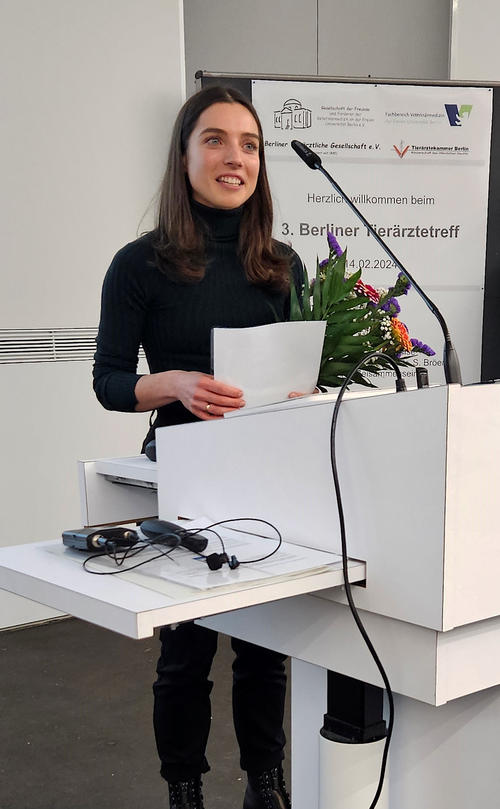Christina Herre: Mit Funfacts, EChristina Herre: Using fun facts, mnemonic devices and nitrile gloves to tackle complex topicsselsbrücken und Nitrilhandschuhen an komplexe Themen
Christina Herre is sporty and musically inclined. In her office, Christina Herre sometimes plays her marimba in the evenings.
Image Credit: Friederike Grasse
Christina Herre thanks for the teaching award
Image Credit: Friederike Grasse
Christina Herre received the teaching award for her course on abdominal situs as part of the Anatomy I - Situs course for the 2nd semester. This is a guided practical seminar in small groups (20-30 students) in which the body cavity, its organs and structures and their positional relationship to each other are taught in theory and practice.
Ms. Herre, do you remember your first lecture?
Yes, of course. It was basically an introduction to the practical anatomy II course. This takes place in front of the entire team, i.e. 150 students plus my colleagues. I was incredibly excited. Thankfully, it went exactly as planned, but that first hurdle and the excitement will stay with me forever.
Why is your topic your topic?
It's always a challenge to go to different bodies and teach them in a textbook way. I like to break down this big topic into small chunks and then translate it from theory into practice. I particularly like the Situs because it is comprehensive. Each body cavity has several topics within it. In the course lesson, we bring these topics together. In this way, the knowledge of all the topics is combined into one big topic. That's when the students have their "aha!" moments. And it's just great to see that.
What do you think you do particularly well?
I manage to create a calm and relaxed atmosphere. This means that the students dare to open up and enter into a dialog with me, respond to my questions and also ask questions themselves. It is particularly important to me that those who are perhaps a little more introverted can also open up. Everyone should have the good feeling that nothing and no one is being judged. Even if the question seems simple or the answer may not be entirely correct, it's still okay. I was very pleased to see in the evaluation that I can also create this atmosphere.
I also try to use the simplest tools to present even complex topics. I love FunFacts, I love mnemonic devices and I use the simplest objects to illustrate things, for example nitrile gloves to model a physiological stomach torsion.
What do you enjoy about teaching and what do you enjoy less?
I particularly enjoy creating "aha!" moments. I find that really nice feedback when my explanations are followed by understanding. Apart from that, I simply enjoy having fun with the students. Making a joke, not taking yourself quite so seriously and laughing at yourself when you make a mistake or make a mistake - all of this helps.
Time limits diminish the joy. Some course hours are very packed. The topics have to be covered, but I have the feeling that I can't really respond to the students and therefore can't really draw on the full potential. I actually think that's a shame sometimes.
What did you appreciate about teachers when you were a student?
I always appreciated it when the lecturer was passionate about their own topic. When I realized that it was fun to teach. I think you automatically absorb the energy that is radiated there and it motivates you to tackle the subject and deal with it yourself. I've always found that inspiring and hope that I can pass it on and incorporate it into my teaching.
Do you have fond memories of your own student days?
Yes, I particularly remember the team spirit among the students during the semester. I got to know some really great people who I can now call friends. This degree course presents an incredible number of challenges, including emotional highs and lows - and overcoming them together is a great bonding experience. It's good to have real allies and to know that you can walk this path together.
What would you like to pass on to your students beyond the pure content?
I would like to tell them not to give up. A subject like anatomy always seems very complex and extensive, but even that is manageable. It is important to me to suggest that you can work on your weaknesses and that you can turn these weaknesses into strengths.



